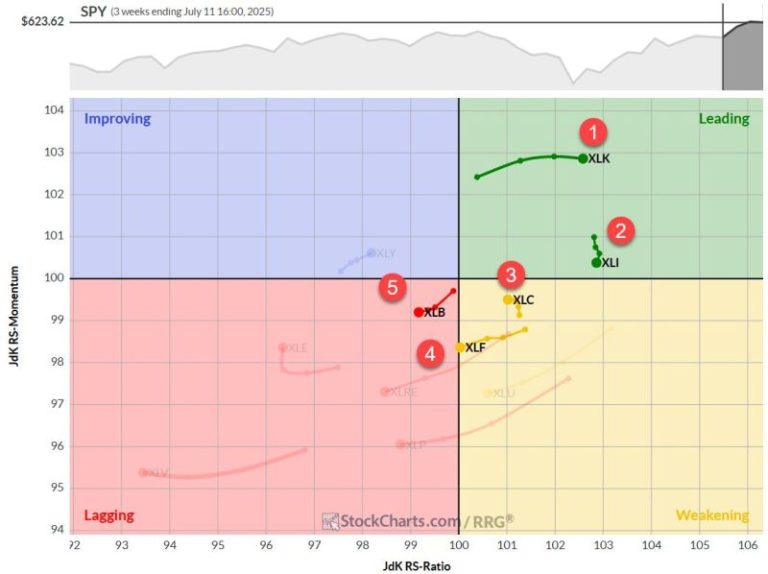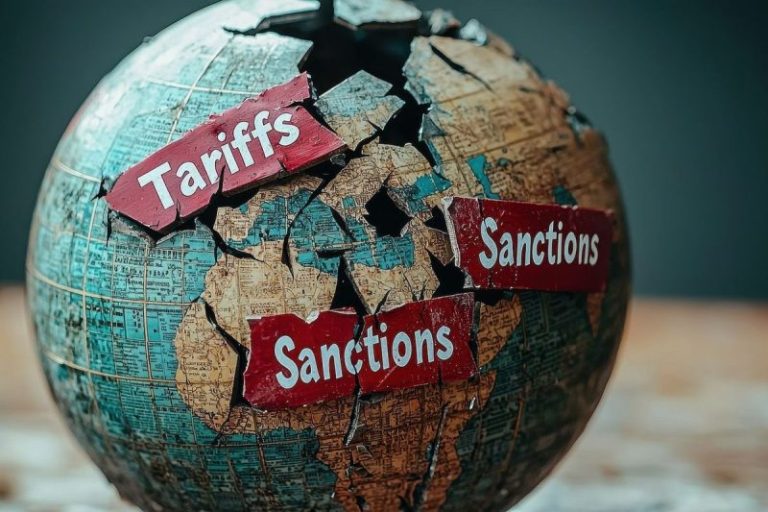Q2 confirmed that the artificial intelligence (AI) boom is entering a new phase in the physical world.
As the industry evolves, attention is being directed to strengthening underlying infrastructure while advancing areas like embodied AI, a subsector that MarketsandMarkets projects will grow at a CAGR of 39 percent globally by 2030.
Also during Q2, a geopolitical tech rivalry exacerbated shifting macroeconomic conditions.
While the race for compute, energy, hardware and supply chain dominance intensified, talk of tariff policies reigniting inflation or contributing to stagflation created brief periods of contraction.
Concerns also grew around AI-driven job displacement, amplified by Anthropic CEO Dario Amodei’s ominous warning that AI could eliminate up to half of all entry-level white-collar jobs within the next five years.
On a more positive note, the S&P 500 (INDEXSP:.INX) and Nasdaq Composite (INDEXNASDAQ:.IXIC) both ended Q2 up by 0.5 percent, closing the first half of 2025 at all-time highs with gains of 5.5 percent.
That said, investor enthusiasm for AI is showing early signs of recalibration.
Big Tech delivered generally robust Q2 earnings despite initial volatility in April, but posted only modest year-to-date gains, suggesting near-term caution around richly valued growth names. Meanwhile, quantum computing, which NVIDIA (NASDAQ:NVDA) CEO Jensen Huang said was decades away just six months ago, made measurable progress in Q2, drawing attention from both deep-tech investors and national governments.
McKinsey’s annual Quantum Technology Monitor projects that quantum computing, communication and sensing could generate up to US$97 billion in global revenue by 2035, with quantum computing leading the way.
Not surprisingly, AI companies performed well. Thirty-eight AI stocks chosen by Morningstar — including Palantir Technologies (NASDAQ:PLTR), Palo Alto Networks (NASDAQ:PANW), Synopsys (NASDAQ:SNPS) and Micron Technology (NASDAQ:MU) — closed 27.3 percent higher, outpacing the Morningstar US Technology Index, which gained 22 percent.
Ultimately, the quarter underscored a strategic pivot for major tech players, prioritizing vast infrastructure investments alongside aggressive AI monetization efforts to capitalize on this transformative era.
AI results impact major tech players
In public markets, AI-related equities continued to attract attention.
NVIDIA posted another blockbuster quarter, with its market cap on the cusp of $US4 trillion at the end of June. Its performance was driven largely by demand for Blackwell architecture.
Alphabet (NASDAQ:GOOGL), facing a possible Chrome divestiture, reported an increase in AI-related ad revenue and highlighted growing adoption of its Gemini model suite. Amazon (NASDAQ:AMZN) reported a 23 percent annual increase in net sales from its Amazon Web Services segment, beating earnings estimates by 17.78 percent.
Meta Platforms’ (NASDAQ:META) Reality Labs division reported a $US4.2 billion operating loss; however, interest in embodied AI applications for the metaverse and augmented reality continue to be the company’s long-term play, with CEO Mark Zuckerberg poaching the industry’s top talent to assemble the Meta Superintelligence Lab. On July 7, Reuters reported that the company had added Apple’s (NASDAQ:AAPL) Ruoming Pang as its latest recruit.
Microsoft’s (NASDAQ:MSFT) OpenAI partnership faced issues after OpenAI bought Windsurf, an AI coding firm. Disputes arose over Microsoft’s access to WindSurf’s IP and its stake in a restructured OpenAI.
Q2 was also marked by a shift to AI in hardware, robotics and edge applications.
Chipmakers Advanced Micro Devices (NASDAQ:AMD) and Google introduced specialized AI accelerators, a potential challenge to NVIDIA’s nearly three year run as the dominant provider.
Notable developments in robotics included Google Cloud and Samsung Electronics’ (KRX:005930) partnership, integrating Google Cloud’s advanced generative AI technology into Samsung’s new home AI companion robot, Ballie.
Data center operators like Amazon Web Services and Google Cloud also increased their infrastructure investments in the US as part of an effort to reduce reliance on foreign markets and secure long-term AI compute capacity.
Companies began testing or rolling out new AI agent capabilities, empowered by the Model Context Protocol from Anthropic. Major tech players, along with payment giants Visa (NYSE:V), Mastercard (NYSE:MA), Stripe, Block (NYSE:SQ) and PayPal (NASDAQ:PYPL), began adopting the Model Context Protocol to integrate seamless payment functionality directly into AI chatbots, moving beyond simple browse to full commerce.
Microsoft enhanced its GitHub Copilot offering with new coding agents capable of autonomous actions, while a handful of companies, including Dataiku, Databricks and Atlassian (NASDAQ:TEAM), introduced tools designed to build, deploy and manage autonomous systems for real-world enterprise applications.
On the quantum computing side, a paper published by researcher Craig Gidney for Google’s Quantum AI division suggests that a quantum computer could break a highly secure 2048 bit encryption, like the kind used for online banking, much faster than previously thought, requiring fewer than a million qubits.
Quantum computing firms later saw their shares spike following bullish comments from NVIDIA’s Huang at his company’s Paris GTC conference. Before Huang’s comments, IBM (NYSE:IBM) announced its development of the world’s first large-scale, error-free quantum computer, set to launch by 2029.
AI trends to watch in Q3
Q2 confirmed the AI cycle is evolving beyond text-based chatbots to hardware, embodiment and commercial uses.
While the Magnificent Seven still largely drove returns in Q2, there’s an expectation that earnings growth will broaden out to other sectors. Picton Investments’ 2025 mid-year update suggests that foundational model growth is encountering headwinds, with competition challenging the need for extensive capital expenditure.
Graph indicating that investor enthusiasm for AI stocks has recently ‘lost altitude.’
Graph via Picton Investments.
However, the firm also suggests that this shift is redirecting the spotlight to real-world AI applications, leading to an expected acceleration of industrial adoption and the creation of new companies.
At this year’s Web Summit conference in May, panelists emphasized the critical role of strategic early stage investments when it comes to navigating the evolving AI landscape and identifying new opportunities.
“Our take is (that) AI is going to upend a lot of technology businesses. In the specific sense, I am of increasingly high conviction that authoring software is going to be more or less free, and that’s going to shake up the topology of the software business market (in terms of) what makes sense and what’s investable,” said Brett Gibson, managing partner at Initialized Capital, during a panel discussion on where AI investment is headed next.
He added that customizable software will ultimately allow for tailored solutions for virtually any need.
In H2, quantum computing could continue its shift from pure research into early stage commercialization.
Updates may come from firms like IonQ (NYSE:IONQ), which recently raised US$1 billion to expand quantum networking, as well as Quantinuum and PsiQuantum, which may reach technical milestones.
Meanwhile, D-Wave (NYSE:QBTS) is pivoting toward hybrid commercial models, which may offer continued proof of revenue from quantum optimization-as-a-service.
However, the outcome of ongoing trade negotiations between the US and the rest of the world could impact chip capacity and rare earths supply chains, constraining the growth of AI hardware stocks.
The Trump administration’s imposition of 25 percent tariffs on Japan and South Korea may pose a threat to semiconductor capacity and rare earths equipment imports critical for AI hardware.
“Both countries have been close partners on economic security matters and have a lot to offer the United States on priority matters like shipbuilding, semiconductors, critical minerals and energy cooperation,” Asia Society Policy Institute vice president Wendy Cutler said in response to the hikes.
Investor takeaway
The second quarter of the year confirmed an evolution in the AI landscape as the industry moves beyond theoretical discussions to real-world applications and critical infrastructure development.
While geopolitical tensions and concerns about job displacement may continue to present challenges, this pivot could set the stage for continued innovation and adaptation as the industry navigates both opportunities and complexities.
Securities Disclosure: I, Meagen Seatter, hold no direct investment interest in any company mentioned in this article.
This post appeared first on investingnews.com










